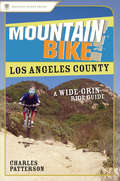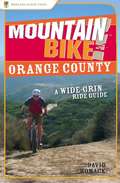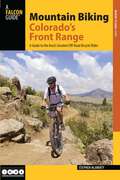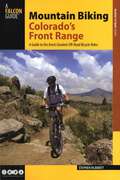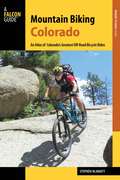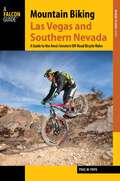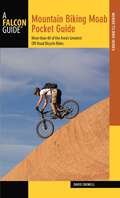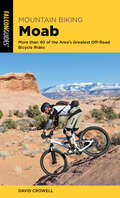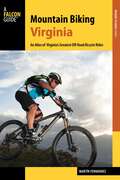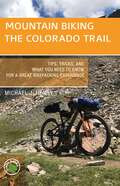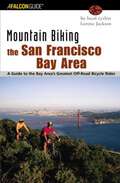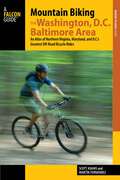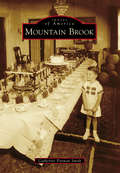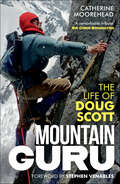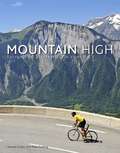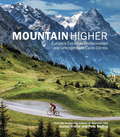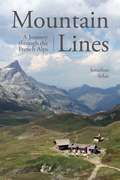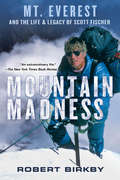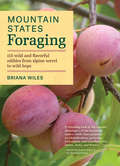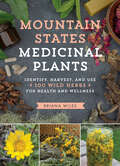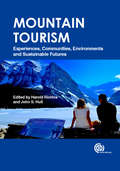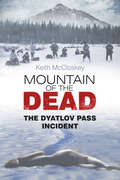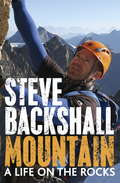- Table View
- List View
Mountain Bike! Los Angeles County
by Charles PattersonMountain Bike! Los Angeles County is must-have literature for the cyclist who is eager to explore the wonderful terrain that housed the genesis of mountain biking in the late seventies. In this trail guide you'll find detailed maps of carefully planned routes, some popular and some unknown to many, as well as comprehensive descriptions of what hazards and delights you'll encounter along the way. Whether you're a adrenalin seeking downhill bomber, or a gram-counting cross country racer, the Wide Grin guide will be your bible. Los Angeles County has every conceivable type of mountain bike accessible terrain, from remote, loamy oak forest floor singletracks without a person in sight, to roller coaster, rock-garden filled chutes that will give you plenty of thrills. Several easier routes for novice riders are also included.Over the years, mountain biking has become a multi-faceted sport, encompassing several disciplines that all utilize the 26-inch knobby tire. The masochistic single-speeder, the cross country racer, the dirt-jumping purist, the downhill racer, the freerider, the epic rider and the weekend warrior will all find their needs catered to in this guide. Each route is rated on technical and aerobic difficulty, so no rider will get more than they bargained for. Additionally, GPS waypoints for the start of each route are given in both UTM and latitude/longitude coordinates, so you'll never find yourself lost.Los Angeles County has enough riding terrain to keep your riding experiences new, fresh, and challenging for a lifetime. Even veteran Angelinos will find themselves surprised at the number of great loops and shuttle-runs unbeknownst to them until now. After a broad tour of LA's mountain bike playgrounds, you'll surely cancel your plans to relocate to Vancouver's North Shore or to the city of Moab, Utah, because Socal truly is the Mecca of mountain biking, and Los Angeles is right in the center of it.
Mountain Bike! Orange County
by David WomackMountain Bike! Orange County covers the gamut of mountain biking behind the Orange Curtain. From the majestic peaks of the Santa Ana Mountains to the rolling grasslands of Chino Hills State Park, there's something for everyone here. Rip extreme drops in Laguna Canyon, explore the vast reaches of the Cleveland National Forest, and race down suburban singletrack on the Fullerton Loop. Whether you are looking for an after work workout or a day long exhibition, this is the book for you. Orange County is not just concrete roadways and Disneyland. There's more E Ticket off-road adventures here than you can shake a spoke at. Mountain Bike! Orange County provides detailed descriptions for all the classic rides and a few undiscovered gems.
Mountain Bike! San Francisco and the Bay Area
by Skye KraftThe San Francisco Bay Area is known for its natural diversity - its forested areas, mountainous peaks, and coastal environments make for an array of outdoor experiences. Mountain bikers of all skill and intensity levels will find many exciting paths to take in this detailed and exhaustive guide.
Mountain Biking Colorado's Front Range: A Guide to the Area's Greatest Off-Road Bicycle Rides (Regional Mountain Biking Series)
by Stephen HlawatyMountain Biking Colorado's Front Range includes over 45 of the greatest off-road mountain bike rides along Colorado's Front Range. A mountain biking atlas to the Front Range region, this one-of-a-kind guidebook details each trail in relation to local history, geology, archeology, legend, and lore. Mountain Biking Colorado's Front Range includes rides near the major Front Range communities of Fort Collins, Boulder, Denver, and Colorado Springs. In addition to the rides, this book also includes additional chapters on mountain bike related topics such as the International Mountain Bicycling Association (IMBA), Any and All Bikes one-stop mobile bike shop, and Denver's famed HandleBar & Grill. Readers will find highly detailed and accurate maps, route directions, brilliant photography, vivid descriptions, and much more.
Mountain Biking Colorado's Front Range: A Guide to the Area's Greatest Off-Road Bicycle Rides (Regional Mountain Biking Series)
by Stephen HlawatyMountain Biking Colorado's Front Range includes over 45 of the greatest off-road mountain bike rides along Colorado's Front Range. A mountain biking atlas to the Front Range region, this one-of-a-kind guidebook details each trail in relation to local history, geology, archeology, legend, and lore. Mountain Biking Colorado's Front Range includes rides near the major Front Range communities of Fort Collins, Boulder, Denver, and Colorado Springs. In addition to the rides, this book also includes additional chapters on mountain bike related topics such as the International Mountain Bicycling Association (IMBA), Any and All Bikes one-stop mobile bike shop, and Denver's famed HandleBar & Grill. Readers will find highly detailed and accurate maps, route directions, brilliant photography, vivid descriptions, and much more.
Mountain Biking Colorado: An Atlas of Colorado's Greatest Off-Road Bicycle Rides
by Stephen HlawatyWhere else can mountain bikers complement a day's bike ride with a dizzying glissade down a mid-August snowfield? Where else can they descend nearly 40 miles through five biogeographical zones? Where else can they catch a major league game and be ripping along rocky singletrack 30 minutes later? Colorado, that's where. Snow in August, lighting above timberline, and 100 degree desert temperatures are all to be expected in the sport of Colorado mountain biking. As the country's highest state, Colorado offers its mountain bikers a unique perspective into the sport and raises the bar for all who ride. Under the expert guidance of local cyclist Stephen Hlawaty, come admire the beauty and revere the majesty that is Colorado. From this newly revised book, cyclists can expect exhaustive and comprehensive trail descriptions of more than 50 of the state's greatest mountain bike adventures, from beginner to advanced. Included are GPS-quality, digitally designed relief maps, and accurate route profiles showing the ups and downs of each ride. In addition, detailed directions get cyclists to the ride without getting them lost. Detailed mile-by-mile directional cues are also provided with difficulty ratings, elevation gain, trail contacts, and much more. More than 60 photographs round out this book's presentation. It's not just a mountain bike guide to Colorado. It's a guide to Colorado by mountain bike.
Mountain Biking Las Vegas and Southern Nevada: A Guide to the Area's Greatest Off-Road Bicycle Rides (Best Bike Rides Series)
by Paul W. PapaMountain Biking Las Vegas and Southern Nevada is the real treasure found within Nevada, detailing over 40 of the greatest off-road mountain bike rides in the Las Vegas valley. Each route includes complete point-by-point miles and directions, map, text description of the riding area, GPS coordinates of the start/finish point, and full-color photos of the ride's features. More than just a trail guide, Mountain Biking Las Vegas gives the reader important information, such as local restaurants, restrooms, lodging, Las Vegas natural history, fauna, climate conditions, bicycle shops, other facilities for cyclists, and community resources.
Mountain Biking Moab Pocket Guide: More than 40 of the Area's Greatest Off-Road Bicycle Rides (Regional Mountain Biking Series)
by David CrowellA handy pocket-sized guide to mountain biking in Moab, Utah. Detailed ride descriptions make it easy to find the trailheads and follow the routes, helping mountain bikers stay on track with accurate distances keyed to easy-to-read maps and ratings for physical and technical difficulty.
Mountain Biking Moab: More than 40 of the Area's Greatest Off-Road Bicycle Rides (Regional Mountain Biking Series)
by David CrowellTheMountain Biking Moab Pocket Guide gives fat-tire enthusiasts the skinny on where to ride in this southwestern Mecca for mountain biking. The best rides around Moab, in Canyonlands and Arches national parks, high in the La Sals, and along the Colorado River are all covered in this handy pocket-size guidebook. Detailed ride descriptions make it easy to find the trailheads and follow the routes, with easy-to-read maps and ratings for physical and technical difficulty. This guide will help mountain bikers choose a ride that's appropriate for their fitness and skill level and is an indispensable companion for all their fat-tire fun.
Mountain Biking Virginia: An Atlas of Virginia's Greatest Off-Road Bicycle Rides
by Martin FernandezPlunge down steep, rugged singletrack, relax along leisurely lakeside trails, or travel off-road through Virginia&’s scenic horse and wine country with Mountain Biking Virginia. Local mountain biker Martín Fernández shows both novice and experienced cyclists how to get out of the gridlock and into the woods.Look inside to find:Detailed ride descriptionsGPS coordinatesFull-color photos throughoutTips on riding, trip preparation, and bicycle maintenance Accurate directions, difficulty ratings, trail contacts, and moreWherever you ride and whatever your skill level, let Mountain Biking Virginia be your guide to this mountain biking paradise.
Mountain Biking the Colorado Trail
by Michael J. HenryThis is the essential how-to book for bikepacking on the Colorado Trail, whether you want to ride a segment or two on the weekends, or all 535 miles in one go. It is a companion resource that includes bike-specific information missed by other Colorado Trail guidebooks. It also serves as an experiential resource for riders, written in a friendly, casual style from one mountain biker to another. Join Michael J. Henry as he shares the tips and tricks you need to know for each segment of the Trail while also answering the experiential questions through stories about his time completing the whole Trail over the course of three summers.In addition to the cold, hard data about the Trail, you will benefit from Henry's practical and honest advice on things like: • Training – how to prepare your legs, your mind, and your gear • Your bike – what you'll want, what you'll need, and how to prep the machine • Gear – camping gear, clothing, supplies, technology • Food and water – what you'll need, and a little bit about calorie and hydration physiology • A rough 17-day plan that can be expanded or shortened • Short interviews with others who have ridden the Trail • The good, the bad, and the okay about eating and sleeping on the Trail • The Zen of riding and suffering – the mindset you'll need, how to deal with pain and self-doubt, and how keep up morale
Mountain Biking the San Francisco Bay Area: A Guide To The Bay Area's Greatest Off-Road Bicycle Rides (Regional Mountain Biking Series)
by Lorene JacksonThis handy guide offers more than 80 rides from the birthplace of the mountain bike revolution; from the top of Mount Tamalpais to the redwoods of Big Basin. Ride legendary Repack, Annadel State Park, Mount Diablo, Wilder Ranch, Henry Coe State Park, and El Corte de Madera Creek Open Space Preserve. Mountain biker, triathlete, and author Lorene Jackson offers tidbits on local history, wildlife, and points of interest to make this more than just a trail guide to the best mountain bike rides in and around the San Francisco Bay Area, including rides in the North Bay, South Bay, East Bay, and San Francisco Peninsula.
Mountain Biking the Washington, D.C./Baltimore Area: An Atlas of Northern Virginia, Maryland, and D.C.'s Greatest Off-Road Bicycle Rides (Regional Mountain Biking Series)
by Scott Adams Martin FernandezPlunge down singletrack over the Allegheny Mountains in Maryland, or travel off-road through Virginia&’s scenic horse and wine country with this fully updated and revised Mountain Biking the Washington, D.C./Baltimore Area. Featuring the greatest off-road bicycle rides of Northern Virginia, Maryland, and Washington, D.C., readers will find maps, color photos, GPS coordinates, and much more.
Mountain Brook
by Catherine Pittman SmithNestled in the over-the-mountain suburbia of Birmingham, Mountain Brook was originally hunting grounds for Creek, Choctaw, Cherokee, and Chickasaw Indians. First settled in the 1820s in the area called Shades Valley, it was not until 1926 that Robert Jemison Jr. began developing Mountain Brook Estates into its present form. Jemison had enormous vision honoring its natural beauty, and he hired regional planner and landscape architect Warren H. Manning of Boston to design a secluded residential community of handsome homes and amenities. Mountain Brook was incorporated in 1942 and experienced a resurgence of growth and expansion after World War II. The neighborhoods were designed to be anchored by villages as community centers for residents within walking distance. Still in touch with the vision and principles on which Robert Jemison founded Mountain Brook, its citizens enjoy the avant-garde villages full of restaurants, specialty gift shops, groceries, and parks, as well as its scenic natural landscape.
Mountain Guru: The Life of Doug Scott
by Catherine MooreheadDoug Scott was a legend among mountaineers. His expeditions, undertaken over a period of five decades, are unparalleled achievements. This book describes the extraordinary drama of them all, from the Himalaya to New Zealand, Patagonia, Yosemite and Alaska. It includes his famous ‘epic’ on The Ogre, one of the hardest peaks in the world to climb, his ascent of Kangchenjunga without supplementary oxygen and his ascent, with Dougal Haston, of Everest in 1975. Catherine Moorehead also uncovers the elusive man behind the obsessive mountaineer. From his rumbustious youth in Nottingham through two tempestuous marriages to a secure third marriage, she shows how Scott matured in thought and action as his formidable global reputation increased. In doing so she reveals him to be a clash of opposites, an infuriating monomaniac who took extraordinary risks yet who developed a deep interest in Buddhism and inspired widespread affection. Scott spent almost as long as his climbing career in founding and developing Community Action Nepal, providing schools and health posts in remote parts of Nepal, where he is still much revered. Doug Scott died in 2020.
Mountain High: Europe's 50 Greatest Cycle Climbs
by Daniel Friebe Pete GodingSHORTLISTED FOR THE BRITISH SPORTS BOOK AWARDS Mountain High is a book for cyclists of all interests and abilities - from experienced club racers to enthusiastic amateurs looking for the world's greatest cycle challenge. Packed with practical route information and advice on each climb, Daniel Friebe's beautifully written text explains why each mountain pass merits inclusion in the top 50 with superb descriptions of the majestic scenery, the heroic deeds of cycling's legendary riders or the sheer endeavour and exhilaration of reaching the summit. With over 250 specially commissioned photographs taken by specialist cycling photographer Pete Goding, this really is the ultimate guide to Europe's 50 best climbs.Featured rides include: Tour de France icons Alpe d'Huez, Col du Galibier, Mont Ventoux, Col de l'Izoard and Col du Tourmalet; the Passo dello Stelvio, Passo Fedaia, Le Tre Cime di Lavaredo and other sacred summits from the Giro d'Italia; plus Spain's formidable Alto de l'Angliru, Austria's Grossglockner and forty more mountain legends.
Mountain Higher: Europe's Extreme, Undiscovered and Unforgettable Cycle Climbs
by Daniel Friebe Pete GodingThe hidden gems of Europe's best roads and passes, from the authors of the hugely successful Mountain High.Following the success of Mountain High: Europe's Greatest Cycle Climbs comes a volume focusing on the continent's lesser-known, challenging and spectacular mountain roads and passes. From the heights of the Ötztal Glacier Road in Austria to the 'secret' side of the legendary Alpe d'Huez, Mountain Higher: Europe's Extreme, Undiscovered and Unforgettable Cycle Climbs explores 50 soon-to-be cult locations and captures stunning scenery from off the beaten track. Featuring the technical details (maps, profiles, lengths, heights) that made Mountain High an indispensable reference book, as well as dynamic descriptions of the routes themselves and Pete Goding's breathtaking photography, this book is a stylish and practical guide to the hidden gems that every true cycling enthusiast needs to know about.
Mountain Lines: A Journey through the French Alps
by Jonathan ArlanA New York Times best summer travel book recommendationA nonfiction debut about an American’s solo, month-long, 400-mile walk from Lake Geneva to Nice. In the summer of 2015, Jonathan Arlan was nearing thirty. Restless, bored, and daydreaming of adventure, he comes across an image on the Internet one day: a map of the southeast corner of France with a single red line snaking south from Lake Geneva, through the jagged brown and white peaks of the Alps to the Mediterranean sea?a route more than four hundred miles long. He decides then and there to walk the whole trail solo. Lacking any outdoor experience, completely ignorant of mountains, sorely out of shape, and fighting last-minute nerves and bad weather, things get off to a rocky start. But Arlan eventually finds his mountain legs?along with a staggering variety of aches and pains?as he tramps a narrow thread of grass, dirt, and rock between cloud-collared, ice-capped peaks in the High Alps, through ancient hamlets built into hillsides, across sheep-dotted mountain pastures, and over countless cols on his way to the sea. In time, this simple, repetitive act of walking for hours each day in the remote beauty of the mountains becomes as exhilarating as it is exhausting.Mountain Lines is the stirring account of a month-long journey on foot through the French Alps and a passionate and intimate book laced with humor, wonder, and curiosity. In the tradition of trekking classics like A Short Walk in the Hindu Kush, The Snow Leopard, and Tracks, the book is a meditation on movement, solitude, adventure, and the magnetic power of the natural world.
Mountain Madness: Scott Fischer, Mount Everest, and a Life Lived on High
by Robert Birkby“An extraordinary life.”—The New York Times Book Review “A fitting homage to one of the great outdoor extremists.”—Kirkus Reviews Legendary climber Scott Fischer found in Mount Everest a perfect landscape for his fearless spirit. Scaling the world’s highest peak tested his skills, his courage, and his endurance. His legendary final expedition—and its tragic outcome—are portrayed in Everest, the 3-D movie adaptation starring Jake Gyllenhaal as Scott Fischer. Robert Birkby, one of Scott’s close friends, captures in this intimate and stirring portrait who Scott Fischer really was and what led him to climb to the top of the world—before he left it altogether. “A personal, uncritical biography that rounds out the portrait of Fischer sketched in Krakauer’s best-seller Into Thin Air.”—The New York Times Book Review “A much fuller picture of a climber widely critiqued in the high-profile coverage after the Everest tragedy.”—Seattle Post Intelligencer “A vivid portrait of a superb athlete whose love of mountain climbing drove everything he did.”—Ed Viesturs, author of No Shortcuts to the Top “Birkby succeeds in illuminating the power mountains can exert over the human soul.—Publishers Weekly Updated with a New Introduction and EpiloguePlus new photos exclusive to the digital edition!
Mountain States Foraging: 115 Wild and Flavorful Edibles from Alpine Sorrel to Wild Hops (Regional Foraging Series)
by Briana Wiles“A stunning look at the natural abundance of the mountain states—with clear guidance on identification, gathering techniques, and uses.” —Jennifer McGruther, author of The Nourished Kitchen The Mountain States offer a veritable feast for foragers, and with Briana Wiles as your trusted guide you will learn how to safely find and identify an abundance of delicious wild plants. The plant profiles in Mountain States Foraging include clear, color photographs, identification tips, guidance on how to ethically harvest, and suggestions for eating and preserving. A handy seasonal planner details which plants are available during every season. Thorough, comprehensive, and safe, this is a must-have for foragers in Idaho, Montana, Wyoming, Utah, Colorado, eastern Oregon, eastern Washington, and northern Nevada.
Mountain States Medicinal Plants: Identify, Harvest, and Use 100 Wild Herbs for Health and Wellness
by Briana Wiles“A practical guide to using medicinal herbs as well as a powerful reminder of our reciprocal relationship with the natural world.” —Rosalee de la Forêt, author of Alchemy of Herbs In Mountain States Medicinal Plants, Briana Wiles is your trusted guide to finding, identifying, harvesting, and using 120 of the region’s most powerful wild plants. You’ll learn how to safely and ethically forage and how to use wild plants in herbal medicines including teas, tinctures, and salves. Plant profiles include clear, color photographs, identification tips, medicinal uses and herbal preparations, and harvesting suggestions. Lists of what to forage for each season makes the guide useful year-round. Thorough, comprehensive, and safe, this is a must-have for foragers, naturalists, and herbalists in Idaho, Montana, Wyoming, Utah, Colorado, eastern Oregon, eastern Washington, and northern Nevada.
Mountain Tourism: Experiences, Communities, Environments and Sustainable Futures
by Michael Hall Peter Williams John Hull Kathleen Scherf Dr Michael Lück Lluis Prats Harold Richins Aurelia Kogler Marit Engeset Joel Schmidt Senija Causevic Farhad Moghimehfar Umberto Martini Baikuntha Acharya Simon Milne Anne Terwiel Tracey J Dickson Emmanuelle George-Marcelpoil Sydney Johnsen Michael Volgger Billy Colins Elizabeth Halpenny Peet van der Merwe Axel Dreyer Anita Zehrer Robin Reid Sanjay Nepal Robert Hood Thorvardur AransonMountains have long held an appeal for people around the world. This book focusses on the diversity of perspectives, interaction and role of tourism within these areas. Providing a vital update to the current literature, it considers the interdisciplinary context of communities, the creation of mountain tourism experiences and the impacts tourism has on these environments. Including authors from Europe, Asia-Pacific and North America, the development, planning and governance issues are also covered.
Mountain Tourism: Experiences, Communities, Environments and Sustainable Futures
by Michael Hall Peter Williams Kathleen Scherf Dr Michael Lück Lluis Prats Aurelia Kogler Marit Engeset Joel Schmidt Senija Causevic Farhad Moghimehfar Umberto Martini Baikuntha Acharya Simon Milne Anne Terwiel Tracey J Dickson Sydney Johnsen Michael Volgger Billy Colins Elizabeth Halpenny Peet van der Merwe Axel Dreyer Anita Zehrer Robin Reid Sanjay Nepal Robert Hood Thorvardur Aranson Emmanuelle GeorgeMountains have long held an appeal for people around the world. This book focusses on the diversity of perspectives, interaction and role of tourism within these areas. Providing a vital update to the current literature, it considers the interdisciplinary context of communities, the creation of mountain tourism experiences and the impacts tourism has on these environments. Including authors from Europe, Asia-Pacific and North America, the development, planning and governance issues are also covered.
Mountain of the Dead: The Dyatlov Pass Incident
by Keith McCloskeyIn January 1959, ten experienced young skiers set out for Mount Otorten in the far north of Russia. While one of the skiers fell ill and returned., the remaining nine lost their way and ended up on another mountain slope known as Kholat Syakhl (or ‘Mountain of the Dead’). On the night of 1 February 1959 something or someone caused the skiers to flee their tent in such terror that they used knives to slash their way out. Search parties were sent out and their bodies were found, some with massive internal injuries but with no external marks on them. The autopsy stated the violent injuries were caused by ‘an unknown compelling force’. The area was sealed off for years by the authorities and the full events of that night remained unexplained. Using original research carried out in Russia and photographs from the skier's cameras, Keith McCloskey attempts to explain what happened to the nine young people who lost their lives in the mysterious ‘Dyatlov Pass Incident’.
Mountain: A Life on the Rocks
by Steve BackshallSteve Backshall's love affair with the mountains has taken him to some of the world's wildest places, environments that have the power to make a human being feel very small, very vulnerable and very alive. MOUNTAIN: A LIFE OF THE ROCKS is an account of his most breathtaking expeditions: heading into the 'Death Zone' on the roof of the world in the Himalayas, and picking a precarious route up hundreds of metres of rock in the Arctic and Alps. There are expeditions of exploration, as Steve makes the first ascent of jungle peaks and scales the tabletop mountains of the 'Lost World', Venezuela's Gran Sabana, in search of undiscovered animal species on their summits. Steve recalls his apprenticeship in the art of mountaineering with the Indian army, and the terror and near-disaster of some of his more ill-fated adventures, including the aftermath of the fall that should have ended his life.This is a tale of terror and ecstasy, a book that tries to get to the heart of why we risk our lives to climb and conquer. But most of all, MOUNTAIN is a love letter to the wilderness, from one of the world's most adventurous spirits.
